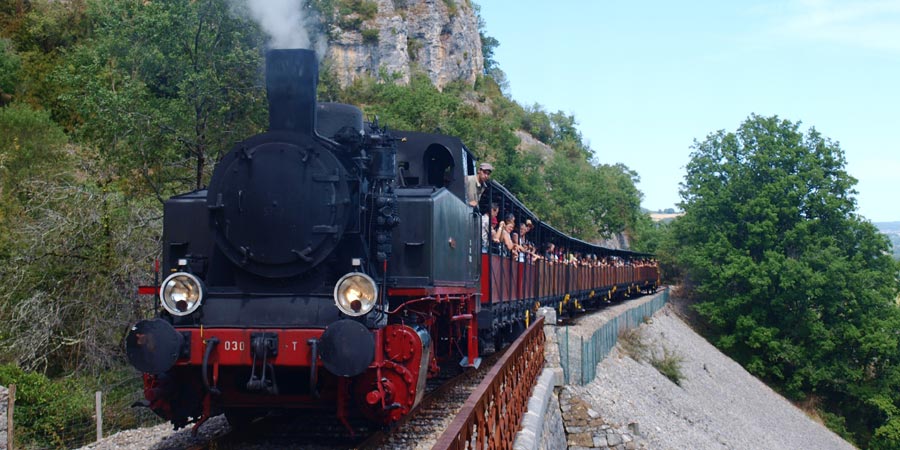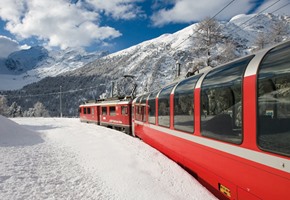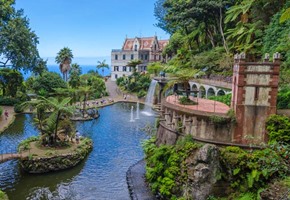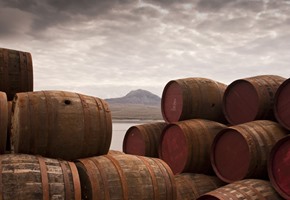The Truffadou train, or the "Chemin de Fer Touristique du Haut Quercy", (Haut Quercy - the old name for a region similar to the present size of the department of the Lot), as it is officially known, is a non-profit railway run by 5 paid permanent staff, some volunteers and has a total of 130 members.
Prior to its completion, flat-bottomed boats, called Gabares, were used to carry timber from the forest of the Massif Central to Bordeaux to make wine casks. These large craft would also carry salt and other precious products, up river, as far as was navigable. Smaller boats, while used for transporting cargo were often broken up and used as timber once their service time was completed.
The railway was built in the 1880s, beginning in 1880 and completed in 1884. It was opened for service between Martel and St Denis les Martel in 1889 when it competed with river traffic on the Dordogne.
It was dismantled by US soldiers in 1917 because of the insatiable demand for Iron during the first world war with the iron used to make bombs for the US in Northern France. The railway was rebuilt in 1919 with help from US soldiers. In the Inter-war period the line was used to transport truffles from Martel Market and it received its name from this time. The railway continued to operate, albeit with dwindling success, until its closure in 1980. The Society for Concerned Enthusiasts Group got together in 1991 and after much hard work began to run trains along its entire original line of 4 miles again in 1997. The French Railway, SNCF agreed to sell the line after a long process of de-classification negotiations about price, conditions and getting local mayoral agreement. Indeed, through tough negotiations the volunteers of the Society managed to get the price reduced by half. In 1999 they gradually added the second and third class carriages and in 2000 a more powerful steam locomotive was acquired from a Polish potato-glue factory. The Truffadou Train was thus, thankfully, rescued. Passenger numbers have increased year on year - for example, there were 48,000 in 2008, 58,000 in 2009 and 64,000 in 2010.
The St Denis to Souillac section of the line was part of the second route from Paris to Toulouse and also part of the line linking the forest of the Massif Central with the wine producing regions of Bergerac and Bordeaux. Each tunnel on the route has its own individual name and date which is noted at either end of the tunnel(s). The Mirandol tunnel is the longest of the five on the St Denis to Martel stretch. This tunnel also has a 7 arch Courtils Viaduct and several bridges. While excavating the next tunnel some prehistoric paintings were found and that tunnel was named Les Peintures.
Though a bit limited there are toilet facilities and a bar locomotive on the train. The journey is a 1 hour round trip. If the weather is not great you should bring some warm clothing or a rain jacket. You should also be aware that it can get a little sooty, especially when we pass through tunnels, so you may wish to wear darker (not white!) clothing. There is a French commentary on the train and an English leaflet is supplied for English speakers. There are a couple of stops for photo opportunities and another at a "hut" where souvenirs and cold drinks can be purchased.
So there we were: 35 intrepid travellers in my group plus me, on day 2 of our tour - day 1 in terms of the programme as we had travelled to France the previous day. All were enthusiastic at the prospect of their Truffadou train journey - the first highlight of their tour. We were met in the station ticket hall by a full size wax version of how the ticket hall used to look. But, certainly more importantly, we were met by the indefatigable, very enthusiastic and effusive Jean Paul, the chief French (and sometimes English) commentator.
We crossed the tracks to the train, which was just beginning to be fired up with a head of steam oozing from its funnel like a dragon taking its ease after combat. We had a reserved carriage, or so we thought, as such was the demand by passengers for the train that we were joined by others, some of whom were prepared and allowed to stand for the journey.
Some of our crew were near the engine and started to feel the heat! The Truffadou lurched into life going backwards first past old rolling stock. The history and "Flintstone Feel" of the train with its complete open sided carriage had everyone in awe and anticipation of the journey ahead. The train pushes ahead, moving under the first tunnel and giving us our first encounter of the smell of steam and coal. Soot begins to encroach into the air. We then go into the second tunnel, the longest, the Mirandol tunnel, which we are told is 2069 metres long. Suddenly we are in darkness for a short time- sufficient time for some people (who - was that me?!) to make ghostly noises to frighten their children as we travelled along. Then the carriage lights come on and all is well with the world again. We emerge from the tunnel and become more conscious of the actual sound of the train across the tracks - it sounded like "Clack, Clack".
Jean Paul's French commentary continues amongst great hilarity from his French audience whereas we just roll our eyes in unison and try to read our English leaflets before hitting the next tunnel. There are some "ooohs" and "aahhs" as we go by especially from one side of the carriage as those there have some great views of the surrounding countryside and over the cliff's 260 foot edge. The Truffadou gathers a pace and the driver sounds the whistle! At that point all members of my group, both men and women, have visions of being Casey Jones with a few starting to sing and hum the signature tune. I try to pretend that I am too young to remember but for some reason nobody believes me. We stop at "the hut" and disembark for a photo opportunity and to buy refreshments. The hut owner is helped in serving everyone by staff from the train. This makes transactions run more quickly and smoothly. Before we know it we are back on the train and have come to the end of the line and turn around for our return to journey. Now the engine is in its rightful place at the front of the train giving us a sense of security. But this soon proves to be unfounded. No one warns you, no one tells you! The Truffadou picks up speed and the "Clack, Clack" becomes more repetitive and a feature. All is well with the world as we go past beautiful scenery. But then disaster strikes as we go through our first tunnel on the way back. We breathe, no indeed, some of us taste and eat, our first mouthful of soot. The whistle blows again as if to say I told you so ! People start to laugh, some cry, bordering on the hysterical. The soot starts to get everyone. Those of my group who had not headed my warning not to wear white were beginning to regret their rebellion. Soot is in our eyes, nose, chest, hair and engulfs all our senses. But just as suddenly as the shock we get used to it and even, dare I say, start to enjoy it. The rumble of the train competes with our Casey Jones theme. We finally arrive back, relatively safe and sound, at Martel Station. We have sufficient time to explore Martel a bit and I decide that this is a good idea, not least to breathe some un-sooted air for a while. If you get a chance, it is worth seeing, as Martelis a medieval town of seven towers and isa minor masterpiece of buildings built in pale, almost white, stone offset by reddish brown roofs. Its narrow streets and old houses with pointed arcs add to the overall sense of history. It is a good way to restore equilibrium after the excesses of the Truffadou Train.
We then join our coach for our return journey to our hotel with everyone still laughing about their experience, pretending to be Casey Jones and comparing notes on what they liked the most about it.





